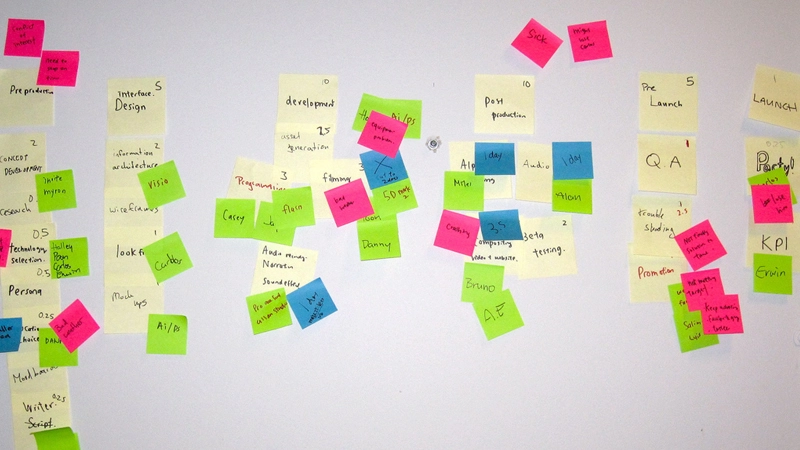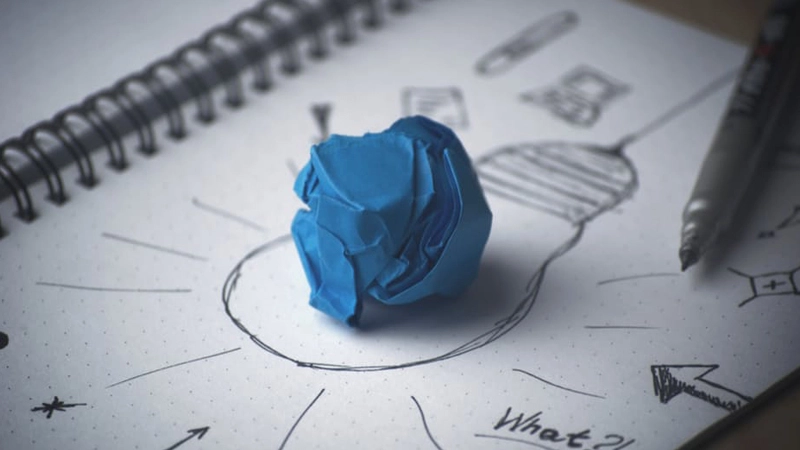Blog
Software development teams face challenges in creating solutions that tick all boxes for their customers. Design thinking is the way to go. It is a problem-solving concept that focuses on users' needs and wants, focusing on practical approaches. Our post explains how integrating design thinking into software development can boost creativity, enhance user experience, and drive innovation.
Traditionally, the word “design” was used to describe the visual aesthetics of the objects. However, the meaning of this word has evolved and it is not that limited anymore. Nowadays, design is not just about form or physical attributes; it’s about new method of thinking. This method refers to the development of products and services, putting customers’ needs at the heart of the development strategy, and using creative and innovative techniques.
Evolution of design thinking approach
Despite having gained its popularity only during the past few years, design thinking
approach is not something totally new. Initially, the concept of this approach was developed
by social scientist and Nobel laureate Herbert A. Simon in his book “The Sciences of the
Artificial” of 1969 year. The scientist developed a theory of three-stage decision making
process: intelligence gathering for defining the problem, design as the process of looking
for a solution to this problem, and choice, which includes analyzing and deciding on the
right option. Then there was Robert McKim’s and his book “Experiences in Visual Thinking”
(1973) describing “Express, Test, Cycle” (ETC) as an iterative backbone of design processes.
Eventually, the concept of “design thinking” as a method of creative action was considerably
expanded by Rolf Faste at Stanford University in the 1980s and 1990s. In business context, design
thinking was adapted by Faste’s Stanford colleague David M. Kelley, who was the founder of IDEO
– a firm that pioneered in this new view of design.
Design thinking itself
So what does design thinking exactly mean?
There is no one and only definition of design thinking. It is said to be “a formal method for practical, creative resolution of problems or issues, with the intent of an improved future result”. Design thinking is a set of tools that enables solving a particular problem using analytics and creativity. Solving the problem is at the core of design thinking. It is a human-centric approach that puts a customer in the center of attention. This approach is aimed at learning which product or service a user wishes for, exploring the ways to make it, developing and testing the product. It’s about being solution oriented and focusing on the ways to solve the problem, not the problem itself.

Design thinking approach involves looking at already existing product and analyzing the ways to make it better and more user-friendly. It’s about generating a plenty of new ideas, while placing the needs of customers above all. This approach can be applied everywhere, including business and non-business sectors.
The relevance of design in software development
Software development doesn’t work just by itself. It has
to empathize with the customer. Customers don’t concentrate on which technologies were used
while making the application or solution they need. They mainly focus on utility, which is
why the developers also have to focus on it.
There is a common situation of misunderstanding happening between the solution developers and
the customers. Of course, it can be said that this is a problem of miscommunication which can
be solved by arranging more calls, meetings, and discussions. However, the solution may be found
much deeper. Only understanding and empathizing with your clients can show you what they really
want. And that is what you should start with.
So, it is not about the right techniques, but more about critical thinking. Nowadays, software
development is everywhere. Nevertheless, with all the codes and technical tools everything is
made by people for people. Software development is supposed to make our lives better and easier,
which is why it’s so important to understand what user needs and wants, and implement design
thinking approach.
Design thinking process
The Institute of Design at Stanford developed the following 5 stages of design thinking process: empathy, defining, ideating, prototyping, and testing.
Empathy
Empathy is the ability to feel and understand what other people experience, put oneself in somebody’s shoes. It is an initial step of the entire design thinking process because empathizing with the customers enables understanding their needs and finding out what they really want, looking at the products and services from your users’ perspective.

This goal can be achieved by means of different interviews and observations. Interviewing must resemble a conversation. You don’t need to influence the answers because your main point is to understand a user. So, questions beginning with “Why” or asking the stories can give you valid results. However, what people tell can sometimes differ from what they do. That’s why, it is so important to observe the interactions and notice what is easy, causes difficulties, and what can be improved.
Define
After empathizing with your customers, there comes the phase of identification of the
problem you need to solve. This step is about summing up and making sense of the information
you received from the previous one. You have to set your problem statement and make it
clear.
At this stage you have to consider thoroughly everything you gathered while empathizing. You
have to define a point of view, consisting of the following elements: users, their needs, and
insights. You have to establish deep understanding of your character – the user. Outline a set
of needs your user has and provide insights, based on your research and discoveries. Your goal
is to set a frame, which makes the problem you are working on clearly defined and understandable,
and encourages the members of your team to find the solutions.
Ideate
Now, you need ideas. Having identified your problems you come to generating solutions. It’s
of the utmost importance to gather as many ideas as you can. What you need is a plenty of
creative solutions, multiple perspectives, and different viewpoints. It is an exploration
phase, where all the ideas must be encouraged even if they seem to be not relevant enough.
You have to imagine what you want to reach and all the ways to get there.
When applying divergent thinking, you gather a great deal of ideas, generating far more than
just obvious solutions. Brainstorming is irreplaceable here. It must include no judgments, a
lot of imagination and creativity, concentration on quantity, listening to others’ ideas and
building on them new ones, and encouraging stupid and crazy opinions while using visual elements
within some limited amount of time. You can also involve people from other departments to participate.
After that, it’s time for convergent thinking in order to select a list of the best options you
put forward.
Prototype
Then it’s time to make a draft. You have to represent your idea in a clear and tangible form so that others could understand. Remember, it doesn’t have to be perfect. It can be in a form of product, model or a sketch, but the primary aim of building a prototype is to pass your idea to the others and figure out how your product may feel and look.

The strong advantage of building a prototype is being able not to spend too much money and effort on it because it’s just a draft. But, at the same time, this draft is a result of all the previous stages and it demonstrates the way your product may look like. You can make a paper prototype by sketching out the product’s features, a prototype in a form of interactive wireframe, or coded one.
Test
In this final stage of the design thinking process, your prototype is put into action and
tested by people. You give it to users, see how they interact with it, how they implement
it, and get your feedback. This phase allows you to understand what is right and what is
wrong, and refine your ideas.
You should pay attention to the users who represent your target audience. Testing can be conducted
several times after every major iteration in order to make sure what works and what doesn’t.
You have to be ready for failures, because they are integral part of making your ideas work.
Noticing mistakes and improving them on this stage is incredibly valuable experience that prevents
you from a great deal of costs and efforts in the future.
Design thinking and Agile
Despite the fact that both agile and design thinking approaches work in constantly changing environments with the same business requirements, they look like something hard to combine. As it has been mentioned before, design thinking is a human-centric approach that concentrates on customers’ needs, and first of all on problem solving. On the other hand, agile takes incremental and iterative approaches focusing on requirements, not problems, and uses them on the phase of development. Agile was initially developed opposite to Waterfall and its limitations giving more flexibility to designers to make changes regarding evolving requirements and product progress.

So, design thinking is more about understanding the problem, while agile concentrates on its
execution. This way, these two approaches are different, but at the same time can complement
and even benefit from each other. Both design thinking and agile focus on collaboration of
individuals, but with their own language and techniques.
Design thinking is a great help in determining the requirements, based on customers’ wants and
needs. These requirements, built on individual features and user stories provide the foundation
for future sprints and development of a product. However, companies that try to combine these
two methods often face difficulties, hesitating how much time must be spent on design and planning,
whether they waste their time on it, and when it’s time to “do the real thing” and start coding.
The combination of agile and design thinking is based on “people over the process” approach,
constant innovation, continuous learning, effective communication, and working iteratively applying
different visual techniques. Synthesis of agile and design thinking may not be an easy process
to start and can cause some disagreements, but using them the right way can result in a very
effective business strategy.
Design thinking approach in product development
Creating a product never guarantees you success. This world knows a billion of stories when
predictions were not confirmed and products failed or unexpectedly succeeded. Product development
does not always pay off. There appear more and more different techniques, approaches, tools created
and put in use in order to predict and assure product success at least to some extent. Many companies
are into developing a
minimum viable product (MVP)
– a rapidly built product with a minimum number of features enough to deploy it and get enough
learning about its use. It’s a great tool to test a product and see whether it satisfies customer’s
needs and generates demand.
Here comes design thinking approach with its empathizing with the users and concentrating on
their requirements. So, you need to start with defining what your target customer needs and what
solution you can suggest in order to satisfy it. Consequently, you define the minimum must-be
set of
features your MVP must have and its functional requirements. After that, you have to pass
the idea and vision to the members of your team and assign tasks to them.

When you MVP is created and it’s time to test it, you have to use web analytics and other tools in order to get maximum valuable information from customers and improve your product in the future. It’s important to thoroughly review the feedback before you start all this process all over again. You have to be ready that your customers don’t always accept the product and you might have to restructure it. Therefore, implementing the design thinking approach in your product development, especially when it comes to launching MVP, reduces the risks of making a product, which wouldn’t satisfy customer needs.
Conclusions
So, the design thinking concept may seem a little confusing and hard to implement at the beginning. Nevertheless, the main thing you should know here is that it concentrates on the users and their needs. It’s about empathizing with your clients, defining the problem you want to solve, brainstorming as many ideas as possible, developing prototypes of the most relevant ones, and testing them. Integrating design thinking within the
system development life cycle
can significantly enhance software development projects by ensuring that user needs are at the forefront of every phase.
This way of thinking can be applied to any product or service, but in the era of evolving information technologies, it is highly relevant in software development. It can be quite challenging to start using this approach in a company, which has already established itself, but it will definitely pay off.
